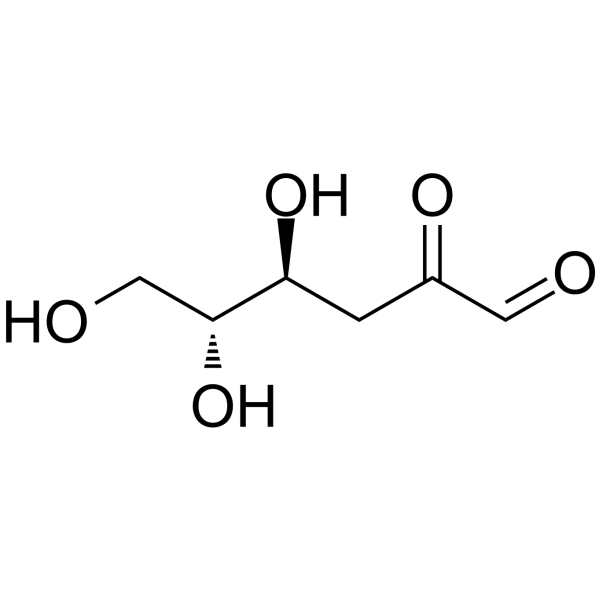天然产物 糖类和糖苷 Saccharides and Glycosides
3-Deoxyglucosone;(Synonyms: 3-Deoxy-D-glucosone)
3-Deoxyglucosone (3-Deoxy-D-glucosone) 是美拉德反应和多元醇途径的反应中间体 (intermediate)。3-Deoxyglucosone 与蛋白质氨基快速反应形成晚期糖基化终产物 (AGEs),例如咪唑啉酮,它是 3-DG 的最特异 AGE。3-Deoxyglucosone 可以与低葡萄糖协同作用以增强 GLP-1 分泌,可以作为糖尿病生物学检测的标志物。

3-Deoxyglucosone Chemical Structure
CAS No. : 4084-27-9
| 规格 | 价格 | 是否有货 | |
|---|---|---|---|
| 5 mg | ¥5800 | 询问价格 货期 | |
* Please select Quantity before adding items.
| 生物活性 |
3-Deoxyglucosone (3-Deoxy-D-glucosone) is a reactive intermediate of the Maillard reaction and the polyol pathway. 3-Deoxyglucosone rapidly reacts with protein amino groups to form advanced glycation end products (AGEs), such as imidazolone, it is the most specific AGE for 3-DG. 3-Deoxyglucosone synergizes with low glucose to potentiate GLP-1 secretion and is considered as a biomarker for diabetes[1][2][3]. |
||||||||
|---|---|---|---|---|---|---|---|---|---|
| 体外研究 (In Vitro) |
3-Deoxyglucosone (80 ng/ml-1000 ng/ml; 1 hour) markedly increases GLP-1 secretion by 1.23-folds in 300 ng/ml or 1000 ng/ml 3DG-treated group. But at alower concentration (80 ng/ml) has no effects[1].3-Deoxyglucosone (300 ng/ml; 1 hour) dramatically increases intracellular Ca2+ levels by Fluo-3/AM determination (2.5 μM for 30 mins). But 3DG does not affect intracellular cAMP levels in a cAMP Elisa assay[1].3-Deoxyglucosone (300 ng/ml; 1 hour) significantly increases the protein expression levels of TAS1R2, TAS1R3, and TRPM5 under both glucose-free and highconditions[1]. MCE has not independently confirmed the accuracy of these methods. They are for reference only. Western Blot Analysis[1]
|
||||||||
| 体内研究 (In Vivo) |
3-Deoxyglucosone (intragastric administration; 20 mg/kg; single dose) impairs glucose tolerance with increased AUC, but the plasma glucagon levels are not significantly different. It developes impaired glucose regulation (IGR) with obviously pancreatic islet cell dysfunction in kunming mice and SD-rats[2].3-deoxyglucosone (gastric gavage; 5-50 mg/kg; once daily; 2 weeks) is significantly increased in the upper small intestine (1.4-fold), lower small intestine (1.4-fold), ileum (1.4-fold) and colon (two fold) compared with the basal levels in the corresponding control group. In addition, the protein expressions of TAS1R2, TAS1R3 and TRPM5 in both duodenum and colon are significantly decreased[3]. MCE has not independently confirmed the accuracy of these methods. They are for reference only.
|
||||||||
| 分子量 |
162.14 |
||||||||
| Formula |
C6H10O5 |
||||||||
| CAS 号 |
4084-27-9 |
||||||||
| 运输条件 |
Room temperature in continental US; may vary elsewhere. |
||||||||
| 储存方式 |
Please store the product under the recommended conditions in the Certificate of Analysis. |
||||||||
| 参考文献 |
|
